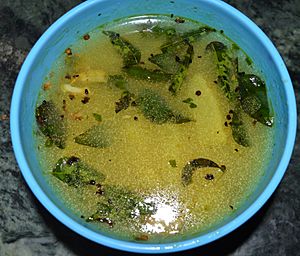Kanji (food) facts for kids

Torani Kanji
|
|
| Alternative names | Ambila |
|---|---|
| Type | Curry, Porridge |
| Course | Side dish |
| Place of origin | India |
| Region or state | Odisha |
| Serving temperature | Warm |
| Main ingredients | Rice water, curd, green vegetables |
| Variations | Dahi Kanji, Paribā Kanji, Torāni Kanji, Sāga Kanji |
Kanji (Odia: କାଞ୍ଜି) is a special dish from Odisha, India. It's made using rice water as its main base. Depending on how it's prepared, you can enjoy it as a warm porridge, a light soup, or even a tasty curry.
Kanji is also very important in religious traditions. It's one of the 56 food items, called Chappan Bhog or Mahaprasad, offered to Lord Jagannath in Puri. This offering is part of the last meal of the day. During an Odia festival called Kanji Anla Osha, people offer kanji to Goddess Sathi.
Contents
Types of Kanji
There are many different ways to make Kanji in various parts of Odisha. Each type has its own unique flavor and ingredients.
Curd Kanji (Dawhi Kanji)
Curd Kanji is a popular type that uses curd (yogurt). There are two main ways to make it:
- Curd Kanji with boiled rice: First, rice is cooked in a large pot called a Karahi (an Indian wok). It's cooked until it's very soft, almost overcooked. Then, turmeric powder and salt are added for flavor. After that, curd is stirred in. Once it's cooked for a bit, it's taken off the heat. A special mix called chhunka is added. Chhunka is made by heating mustard oil and adding spices like pancha phutan (a mix of five spices), crushed ginger and garlic, red chilies, and curry leaves. This gives the Kanji a wonderful aroma and taste. This type of Kanji is often eaten with boiled rice or as a meal on its own.
- Curd Kanji with gram flour: For this version, curd is mixed with gram flour (Besan) or rice flour and then boiled with water. Salt and turmeric powder are added for taste. Once it's cooked, it's removed from the heat, and the chhunka (tempered spices) is mixed in.
Vegetable Kanji (Pariba Kanji)
Vegetable Kanji is packed with healthy vegetables. To make it, different raw vegetables like radish, ash gourd, okra, pumpkin, drumsticks, and aubergine are cut up. These vegetables are boiled in water in a Karahi. Turmeric powder, ginger, and salt are added to the boiling vegetables. They cook until they are soft.
In a separate bowl, curd and gram flour or rice flour are mixed with water. This mixture is then added to the boiling vegetables. Once everything is cooked and the Kanji thickens, it's taken off the heat. Finally, the chhunka (tempered spices) is added and mixed in. Vegetable Kanji is usually served with rice. It's also known as ambila and is very popular in Western and Southern Odisha.
Rice Water Kanji (Torani Kanji)
This type of Kanji uses torani, which is the water left over after boiling rice. This rice water is often left for a few days to ferment. This makes it a bit sour. Sometimes, a piece of Ambula (dried mango) is added to make it even more sour. Fresh rice water is added each day to the fermenting base. When it smells sour, it's ready to be used.
To cook Torani Kanji, various vegetables like pumpkin, radish, drumsticks, beans, ivy gourd, okra, or ash gourd are cut and boiled in the sour torani with some water. Turmeric powder and salt are added. If the rice water isn't sour enough, 1-2 pieces of ambula can be added. Once the vegetables are soft and the Kanji gets thicker, it's taken off the heat.
Then, a chunkaw (tempering) is prepared. This involves heating mustard oil and adding panchaw phutanaw, curry leaves, ginger, and dry red chilies. These are roasted until they change color. This chunkaw is then added to the Kanji. This type of Kanji is especially liked in Southern Odisha.
During the Kanji Anla Osha festival, which happens in October or November, Torani Kanji is offered to Goddess Shathi (Odia: ଷଠି). Other offerings include dried fish, anla, radish curry, and poi. Farmers also offer Kanji to their farmlands. They do this to hope for a good harvest.
Greens Kanji (Shāg / Patra Kanji)
When Torani Kanji is made by adding any kind of greens, known as shag (ଶାଗ) in Odia, it's called shāg or patra Kanji. Common greens used include drumstick leaves (Odia: ସଜନା ଶାଗ), shallot leaves (Odia: ଗନ୍ଧନା gandhanā), purple amaranthus (Odia: କୋସଳା koshala), or gorkura (Odia: ଗୋର୍କୁରା), also known as khtaa palanga (Odia: ଖଟା ପାଳଙ୍ଗ).
Besides these common types, there are also regional variations. Some areas make prawn (Odia: ଚିଙ୍ଗୁଡି chingudi) Kanji, crab (Odia: କଙ୍କଡା kankadā) Kanji, or dry fish (Odia: ଶୁଖୁଆ shukhuā) and khadā (Odia: ଖଡା) Kanji.

